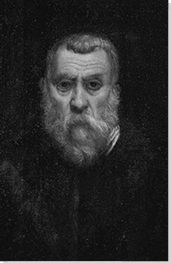Summary of Jacopo Tintoretto
Standing before one of Tintoretto's epic compositions is to be consumed into a world of tumultuous activity, filled with muscular figures interlocked into rhythmic patterns of emotional turmoil and dramatic confrontations. Originally painted to decorate the massive interiors of great halls and sprawling ceilings, the scenes loom threatening to break through the barriers between fictive pictorial space and the physical world. Saint Mark descends from the heavens to protect a defenseless slave, Christ stands amid his disciples and a chaotic scene of attendants during the biblical Last Supper, and even his singular self-portraits reveal the artist's soul instead of simply displaying his style. Tintoretto's ability to collapse these emotional and physical barriers between the viewer and the viewed put the artist at odds with the established decorum of Renaissance idealism, immediately setting this School of Venice artist apart from the vast majority of his peers. Instead, his agitated brushwork set the stage for the succeeding generations of artists who would build on his legacy of artistic marksmanship moving away from an idyllic naturalism toward an increasing sense of abstraction.
Accomplishments
- Tintoretto's complex compositions stand in stark contrast to the geometric harmony typical of the Renaissance period. For this reason, the Venetian artist is often associated with the Mannerist style, itself defined by its break from the traditions set by Raphael and Leonardo. However, Tintoretto is equally a product of his home town of Venice, an artistic region known for its dramatic use of light and color and lively approach to staging traditional religious narratives, as the Mannerist style popular in Florence and Rome.
- Tintoretto exploits the expressive capacity of the human figure in his expansive compositions, such that it is not merely the face but entire figure which communicates the emotional elements of the scene to the viewer. Where the earlier Renaissance artists reflect the sobriety of Classical Greek art, Tintoretto embraces a highly emotive style which anticipates the 17th-century Baroque period.
- Over 400 years before art critic Robert Hughes' influential text on modern art, "The Shock of the New," Tintoretto shocked audiences with his radically different approach to painting with speed, dexterity and overt traces of brushwork across the surface of the canvas. Tintoretto's gestural brushwork would also have a profound influence on successive generations of painters, from the theatricality of Diego Velázquez's Baroque tenebrism to the emotional angst and verdant use of color found in the 19th-century Romantic painters such as Eugene Delacroix and Theodore Gericault.
The Life of Jacopo Tintoretto
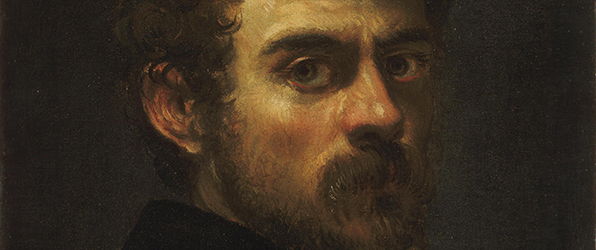
Known as the ultimate Venetian, Tintoretto was not just a groundbreaking artist and astute businessman, he continues to find fans today. David Bowie has collected his work, dubbing Tintoretto “a proto rock star.”
Important Art by Jacopo Tintoretto
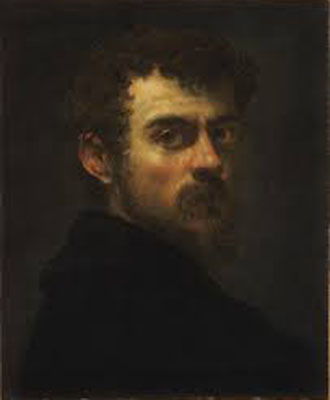
Self-Portrait
Jacopo Tintoretto painted this expressive self-portrait as he reached 30 years old. His dark curly hair, mustache, and beard, along with his black jacket nearly blend into blue-black background while his face appears as if glowing in light against the darkness. The starkness of the composition, quite unlike his densely populated narrative paintings, was unprecedented, as the artist provides no details to indicate a place, context, or even his profession as an artist. Tintoretto's gaze is truly captivating, with his head turned over his right shoulder he stares directly out providing an uncompromisingly direct confrontation with the viewer.
This groundbreaking self-portrait was the opening artwork featured at the exhibition, "Tintoretto: Artist of Renaissance Venice," at the National Gallery of Art, Washington, DC, celebrating the 500th anniversary of the artist's birth. The visibly pronounced brushstrokes, appearing as natural highlights on the artist's face from afar, seem as nearly impasto patches of paint on the surface of the composition as one approaches the work. This key feature of Tintoretto's style, found even in his earliest works, helped to set him apart from the more finished brushwork styles of his Venetian contemporaries such as Titian and Veronese, and would influence the work of his younger contemporaries and subsequent generations of artists. According to Echols and Ilchman, co-curators of the National Gallery's exhibition, "in the context of a self-portrait, the noticeable brush marks, revealing the process by which the painting was created, provide a second self-image of the artist: in addition to showing his physical appearance, the image embodies his distinctive pictorial technique and artistic personality. This may be the first autonomous self-portrait in European art to leave the touch of the artist so evident, functioning almost as a signature. The line that extends to the freely painted self-portraits of Rembrandt, Vincent van Gogh, and Paul Cézanne starts here."
Oil on canvas - Collection of Philadelphia Museum of Art, Philadelphia, Pennsylvania
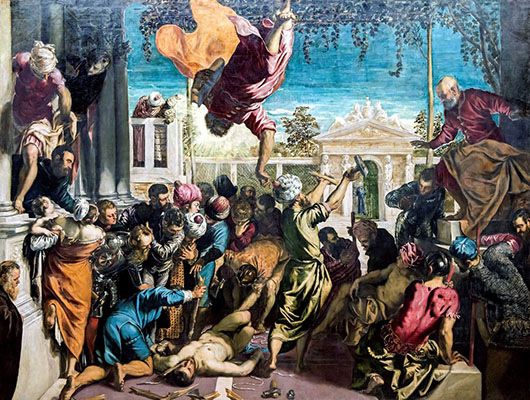
The Miracle of the Slave
A crowd of figures stand gathered around a fallen nude male, seeming to express various states of shock and confusion. A single figure in a pale, green robe and white turban turns away, holding a broken hammer up for the benefit of a startled leader who leans forward, nearly standing, from of his elevated, seated position. An angelic figure hovers over the event. The overall composition of Tintoretto's religious painting, The Miracle of the Slave, although set within an opulent Roman courtyard, is intense with action. This miraculous event depicts the moment a slave, the nude figure, is about to be punished for praying to relics of Saint Mark which his master had forbidden. Three times the executioner attempted to levy the punishment, and each time the tools have broken before the slave could be harmed. This is the work of Saint Mark who, in dramatic fashion, descends from heaven in a red robe and billowing orange cape to rescue the slave and spare him the suffering associated with this painful death. This miracle also converts the slave's master to embrace the Christian faith.
The great influence that Michelangelo had on Tintoretto's artistic style is visible in this work; the robust, muscular figures staged in a variety of complex positions are reminiscent of the Renaissance master. Specifically, art historian Tom Nichols describes a connection between the "...reclining nudes which frequent the foregrounds of important paintings from the late 1540s..." including this work, and Michelangelo's Dusk (1526-34) and Dawn (1526-34). Scholars doubt whether Tintoretto saw the masterworks in person, but instead made studies based on sculptural maquettes or other works based on the originals by Michelangelo.
Despite some of the initial criticism Tintoretto received for the speed at which he worked, made obvious from the loose and gestural brushwork, this painting had a profound impact on Tintoretto's career. A commission for the Confraternity of Scuola Grande di San Marco brought the artist wide attention, after which he began receiving many commissions. Echols and Ilchman explain that, "according to Tintoretto's biographers, some members of the confraternity argued against accepting it, enraging the artist, who took it back to his studio. But eventually, the naysayers were discomfited, Tintoretto and his proponents won the day, and the painting was installed to great acclaim." The acceptance of this work was an essential step towards broadening the stylistic range of the Venetian School. In addition to the more traditional approaches of Titian, here Tintoretto provided a highly dramatic presentation of a religious subject which helped to lay the foundation for the future development of Baroque art.
Oil on canvas - Collection of Gallerie Dell'Accademia, Venice
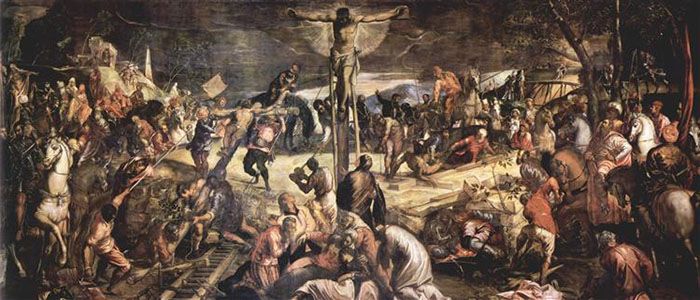
The Crucifixion
Tintoretto's large-scale painting of The Crucifixion features the scene of Christ's death in a dramatic panorama, standing 17-feet tall and just over 40-feet-wide. Amid the tumult of characters, the artist has crafted a complex composition which evokes the preceding events of the Passion, while also suggesting what is yet to occur. The muscular body of Christ hangs heavy on the cross overlooking the mourners who gather at its base, almost crumpled in form and distraught in their grief as they try to comfort each other. Here Tintoretto follows traditional iconography, depicting the agony of the three Marys, St. John the Evangelist, and the two men who will soon lower the body of Christ from the cross, Joseph of Arimathea and Nicodemus. The Virgin appears to have fainted, her body swoons into a graceful curve with one arm outstretched, also anticipating the pending deposition scene by mimicking the form Christ's body will soon take. The artist departs from typical renderings of the scene, however, by showing the two thieves in the process of crucifixion, instead of flanking the body of Christ. This reminds the viewer of the brutality endured by Christ only moments before. On Christ's right, the thief who by tradition repents, is shown looking at his savior while his cross is raised, symbolically suggesting his ascent to Heaven. Conversely, on Christ's left, the man who did not accept Christ, looks away while the executioners begin to nail his body to the cross. Surrounding the main events of this biblical scene, soldiers and other well-dressed figures on horses provide witness to the event, as would the elite members of the confraternity allowed admittance into the hall to view the actual masterpiece.
Created specifically for the boardroom of the Scuola Grande di San Rocco, it is one of the earliest works Tintoretto painted for the confraternity, which would ultimately number approximately 50 paintings completed over the course of more than two decades. While the Crucifixion was a popular subject for artists throughout this period of Western history, Tintoretto distinguishes himself here by presenting one of the most theatrical and densely populated renderings of this subject. Reminiscent of Michelangelo's iconic fresco depicting The Last Judgment on the altar wall within the Sistine Chapel, Tintoretto's "Crucifixion" reveals the influence of the Renaissance master in both composition and approach to the human form. As with his predecessor, Tintoretto's figures are full of movement offering a virtuoso display of technique and foreshortening. The tumultuous action of the earthbound figures, which is characteristic of Tintoretto's style, provides a dramatically sharp contrast to the still figure of Christ, depicted in Majesty surrounded with a glowing halo, as he approaches death. For the devout artist, this was a divine moment which represented his own salvation.
Oil on canvas - Collection of Sala dell'Albergo, Scuola Grande di San Rocco, Venice
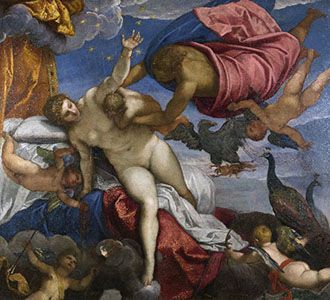
The Origin of the Milky Way
One of four paintings based on the myth of Hercules, Tintoretto's The Origin of the Milky Way depicts the god Jupiter bringing his son, born of a mortal woman, to nurse from the breast of his wife, the goddess Juno. In a composition which anticipates the drama of Baroque painting, the artist creates a scene of flustered activity depicting the moment Juno awakens to discover Jupiter's deceit. According to myth, the infant Heracles would obtain immortality through breastfeeding from the goddess. However, as she awakes, Juno draws away in anger causing her milk to spray across the sky, thus forming the Milky Way indicated by an array of stars. From her other breast, milk falls toward Earth resulting in the creation of beautiful lilies, believed to be part of the original composition (later trimmed down). Below the immortal couple, numerous cupids with bows drawn, symbolize the marital discord and its universal consequences.
The work provides visible proof of Tintoretto's skill as both a draughtsman and colorist. The foreshortening of Jupiter is reminiscent of Giotto's groundbreaking frescos in the Arena Chapel, the muscular Juno the influence of Michelangelo, but the rhythmic arrangement of figures is uniquely Tintoretto. Nichols describes how the expert use of color in both the figures and attire relates to Tintoretto's childhood exposure to pigments in his father's workshop as a cloth dyer. He writes, "immediately noticeable are the range and quality of the pigments used: the composition is built up from a carefully variegated palette which moves from intense blue to grey in the sky, and from white and gold through to orange, pink and scarlet in the draperies."
While best remembered for his religious paintings, The Origin of the Milky Way is one of many mythological paintings Tintoretto created throughout his long career. This particular series of paintings, commissioned from Rudolf II, the Holy Roman Emperor and King of Hungary, is an important indication of the progressive artist's popularity beyond Italy. Interestingly, some mystery surrounds the original impetus for this painting. Some scholars believe it was first painted as a commission for the "grand guardian" of the Scuola Grande di San Marco, Tommaso Rangone, who had commissioned other notable works from the artist, including Finding the Body of Saint Mark. After Rangone's death, the artist reconfigured this painting for the Emperor.
Oil on canvas - Collection of National Gallery, London
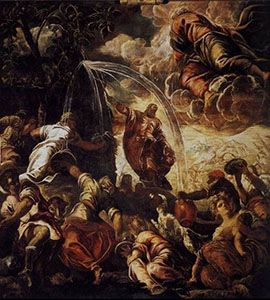
Moses Striking the Rock
In this visualization of the Old Testament story, Tintoretto portrays a scene from the book of Numbers 20:11 which states, "then Moses raised his arm and struck the rock twice with his staff. Water gushed out, and the community and their livestock drank." The artist depicts the precise moment of action when Moses, dressed in billowing red robes, strikes the rock for a second time producing a waterfall spilling out in long flowing arcs. In the foreground of the composition a throng of people rushes towards the water, attempting to fill their vessels and bowls. Watching over the scene in the upper right corner of the composition is a dramatically foreshortened depiction of God. Separating the heavenly realm from this miracle is a prophetic vision; the Israelites are under attack in an act foreshadowing the trials that God's people will face.
Characteristic of Tintoretto's mature style, here as in so many of his paintings, the artist renders the story in the moment of highest drama. The powerful tenebrism, or contrast between light and dark, symbolically contrasts the light from heaven against the earthly figures in darkness below, as well as serving to illuminate Moses who stands nearly central in the composition. The feeling of movement is accented by Tintoretto's sketch-like quality, for which he remains best known, and the depiction of strong muscular bodies contorted in a variety of positions to increase the overall theatrical effect of the scene.
This painting is one of a series of three ceiling works featuring stories from the Old Testament completed for the Scuola Grande di San Rocco where he, once again, demonstrated his ability to push beyond tradition. According to Echols and Ilchman, unlike what had done in prior ceiling paintings, Tintoretto's, "...treatment of space was free and fluid rather than adhering to a unified, strictly rational perspective; he structures scenes based on relationships among the figures." His skill in these paintings was so well received that he went on to create the works for the remaining spaces within the Sala Superiore for the Confraternity of the Scuola Grande di San Rocco making this project collectively his greatest commission.
Oil on canvas - Collection of Sala Superiore, Scuola Grande di San Rocco, Venice
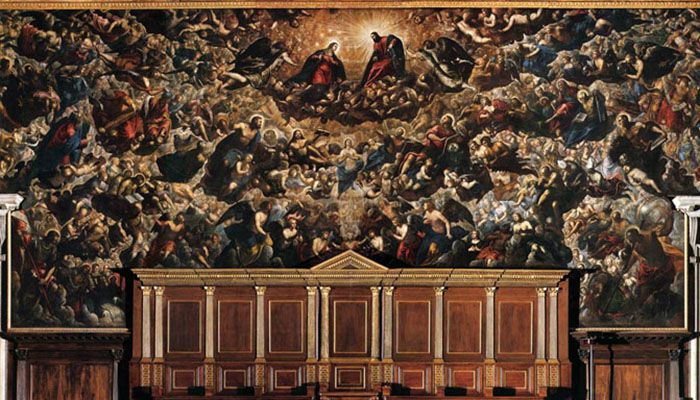
Paradiso
In Tintoretto's epic painting Paradiso (or Paradise), Christ and his mother Mary are depicted in a circle of golden light at the top center of the canvas. They look down upon concentric rings of clouds occupied by saints, angels, and bodies resurrected from their graves who look up towards heaven. An angel approaches Mary, just to her right, extending to her a stem bearing white lilies. Meanwhile, to the left of Christ, an angel is bringing a set of scales to the Christian savior. Tintoretto has woven in the traditional iconography of the Annunciation scene, where the angel Gabriel announces that Mary will carry the child of God, together with the Last Judgment, implied by the artist with the symbol of the scales. The clouds wrap around the central figures, almost likes ripples in a pond, suggesting the continued reverberations of the church's teachings - especially significant during the time of the Counter Reformation.
One of the greatest works of Tintoretto's career, and certainly one of the largest at 23 feet high and 72 feet long, he won the commission in a competition to redecorate the Doge's Palace in Venice after it had been severely damaged in a fire. Even after the death of Titian, the road to this commission was not without challengers; Tintoretto lost it to his younger rivals, first Paolo Veronese and Francesco Bassano who were to complete the colossal painting as a team. Following Veronese's death in 1588, Tintoretto alone gained the commission. The large-scale of the masterwork, however, required an intense physicality of the labor. So, although the artist completed a preparatory large-scale version of the composition, he was unable to complete the final version at full scale. As Echols and Ilchman, explain, "[Tintoretto] lacked the strength to climb up and down the scaffolding and put the final touches on his canvas. So he passed that task on to [his son] Domenico."
Seen from afar, Paradiso is nearly an abstract vision composed of rhythmic patterns of light and color. The work represents the culmination of the artist's years of attention to and mastery of sharp contrasts between light and dark in the intensely rendered figures. According to art historian Giorgio Tagliaferro, the painting is, "...enlivened by color and lighting, which highlight the bodies with powerful chiaroscuro effects ... Jacopo employed a varied repertoire of energetic poses, elaborated over the years in figure studies." The dramatic, almost theatrical quality of Tintoretto's scene would lay the foundation for Baroque art.
Oil on canvas - Collection of the Palazzo Ducale, Venice
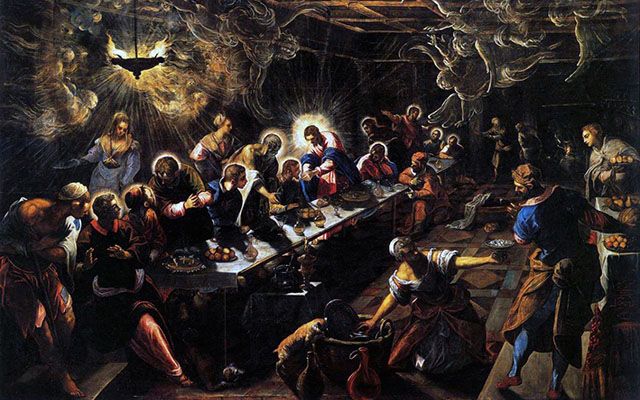
The Last Supper
Painted for the Church of San Giorgio Maggiore, this late version of the Last Supper is perhaps the most unusual and dramatic staging of a scene often depicted by the artist. Tintoretto's painting is anything but symmetrical as even the table itself is set at a sharp angel receding into the dark background of the picture plane. This effectively divides the canvas into two scenes, contrasting the spirituality of the scene on one side of the table with the secular world on the other. In a central position, Jesus Christ stands surrounded by his disciples, all on the far side of the table. Eleven disciples and two women stand on the same side of the table as Christ, one of the women wears blue, the other is in red, symbolic colors associated with The Madonna and Mary Magdalene, respectively. Also behind Christ on the left side of the canvas, the hanging lamp casts out an illusionary glow, a golden circle of light casting rays across the scene accented with trails of smoke that morph into sketchy, translucent-like angels who bear witness to the event. Across the table, and in one way that Tintoretto follows tradition, is Judas, the betrayer, who sits among the servants and staff of the earthly realm, who appear to be serving the Last Supper to the heavenly gathering.
This is an important late painting by Tintoretto featuring a subject he created often throughout his career. This is, arguably one of the most interesting examples in which he depicted a religious subject, popular among patrons and artists, and rendered it in a way that is uniquely his own. Traditionally the iconic subject of Christ's last meal with his disciples depicts the event in a formal hierarchy, with Christ as the focal point sitting among his followers in the center of the canvas, and they are the sole occupants of the scene. Here, Tintoretto offers an almost shockingly different interpretation. Christ stands far back in the compositional space created by the artist, behind the mass of secondary servant figures who crowd the chaotic scene. Most notably Christ does not represent the vanishing point, an approach most famously employed by Leonardo da Vinci. While steeped in Renaissance techniques, works such as this one result in Tintoretto's association by later scholars with the 16th-century tradition of Italian Mannerism. The extremely dark composition, accented with sharp contrasts of bright light to highlight Christ and the celestial angelic figures above, not only sets him apart from the highly saturated use of color usually associated with the School of Venice, but foreshadows the dramatic use of tenebrism employed by Caravaggio and his followers. The strategy of extreme dark and light, paired with a strong diagonal compositional structure, will also become the trademark of Romantic painters, ranging from Theodore Gericault to Francisco de Goya.
Oil on canvas - Collection of Church of San Giorgio Maggiore, Venice
Biography of Jacopo Tintoretto
Childhood and Education
There are few details known about the childhood and early life of the Italian artist Tintoretto. Born Jacopo Robusti, even the year of his birth is unclear with scholars placing it sometime in either 1518 or 1519. He is known to have come from Venice, however, making him one of the few iconic artists of the Venetian School to have been born in this city.
His father, Giovanni Battista Robusti, was a cloth dyer; an occupation which would influence his son's artistic style surrounding the young Jacopo with colors, pigments, and other artistic mediums virtually from infancy. This trade also provided the inspiration for the name he would ultimately adopt, according to art historian Stefania Mason, he "...proudly declared the family connection with dyeing when he adopted the nickname by which he remains best known - Tintoretto, 'the little dyer' - as seen in his signature on paintings as well as various documents."
Early Training
Although no definitive records exist, it is generally believed that Tintoretto's training began sometime in his early teens with a brief stint as an apprentice in the workshop of the famed Venetian painter, Titian. This association did not last long with many speculating it was due to a strong clash of personalities between the old master and the more progressive exuberant and boundary-pushing personality of the young pupil.
Largely self-taught after this experience, Tintoretto would continue to develop his skills in part through making paintings on furniture. In Italy, at the time, there was a great demand for cassoni or ornate chests decorated with paintings, and it is here that Tintoretto is believed to have developed his distinctive approach characterized by rapidly executed loose brushwork often appearing sketch-like and, at times, incomplete. In his book, "Tintoretto: Tradition and Identity," art historian Tom Nichols writes, "In a number of small-scale paintings attributable to his earliest period, Tintoretto radically abbreviates his treatment of form, the sketchy effect being reinforced by his employment of a limited range of broken tones, close to one another on the color scale [...] Works such as these were intended to adorn furniture, and support [early biographer Carlo] Ridolfi's report that Tintoretto associated with painters of this type who peddled their wares from temporary wooden booths set up in St. Mark's Square. Ridolfi tells us that it was in this public (but professionally marginal) context that Tintoretto first learned the 'method of handling colors' particular to the cassoni painters."
Tintoretto's gestural style, although once fashionable with associations to the earlier master Giorgione, was by then equated with the lower ranking cassoni painters. This left Tintoretto out of favor with some of his fellow Venetian artists and patrons. The writings of the artist Giorgio Vasari, best-known today for his biographies of the Renaissance artists, illustrate just how radical Tintoretto's technique was to his contemporary audience. Vasari writes, "this master at times has left us finished work sketches so rough that the brushstrokes may be seen. Done more by chance and vehemence than with judgement and design." While this passage may read as critical, perhaps to show a preference for the internationally recognized, and considerably more polished technique, of Titian, another quote shows Vasari's admiration for the bravura of Tintoretto's brushwork, citing the younger artist as "the most extraordinary brain that the art of painting has produced."
Mature Period
From as early as 1538, there is evidence of Tintoretto having his own workshop and referring to himself as a professional working in Venice. From the outset, the young artist set himself apart from his former teacher Titian, despite the popularity of his rival's accomplishments. Tintoretto's interest in, and emulation of, Michelangelo's approach to painting was especially disagreeable to his former master. According to curators Robert Echols and Frederich Ilchman, as they wrote in the 2019 exhibition catalog, Tintoretto: Artist of Renaissance Venice, the young artist "...presented himself in the role of a challenger to the established tradition as embodied by Titian and identified himself instead with the newest ideas circulating in Venetian painting. In the early 1540s that meant emulating contemporary currents in Florence and Rome, and above all Michelangelo, the biggest name in all of Italian art. [...] While the concept of an avant-garde painter aiming for 'the shock of the new' was not one articulated in the sixteenth century, Tintoretto was positioning himself on the cutting edge of Venetian painting." Unfortunately, Titian never forgave what he considered Tintoretto's disrespect and attempted on numerous occasions to thwart the younger artist's advancement by blocking Tintoretto's success in obtaining commissions and membership in various organizations.

Despite Titian's disapproval, Tintoretto began to make a name for himself, first through a series of public works in the form of mural fresco paintings. He was able to gain work through charging extraordinarily low fees, often only covering the cost of materials, to gain exposure to a larger audience. This strategy proved successful, as Tintoretto began gaining commissions, including many religious works for which he would remain best known, including multiple depictions of the Last Supper, the first of which he created in 1547. Arguably it was his first masterpiece, The Miracle of the Slave, (1548) that brought him to the attention of the larger Venetian public and patrons and, in effect, launched his career.
As Tintoretto began to prosper professionally, he also flourished in his personal life. He became friends with many of the leading literary figures of the day. Then, around 1550 he married Faustina Episcopi whose father was affiliated with the Scuola Grande di San Marco confraternity for whom he had created a painting. They would have eight children; three of whom would become artists.
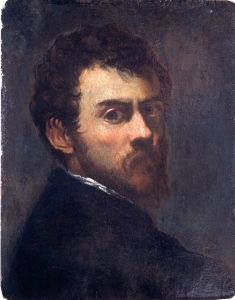
In addition to church commissions, a major source of employment for Tintoretto and other Venetian painters during the 16th century was for confraternities or scuolas. These organizations played a large role in the cosmopolitan Venetian culture, organized around a variety of purposes ranging from national origin to acts of public service, such as helping the ill and poverty-stricken. Over time, these scuolas acquired great wealth from their affluent members which provided a major source of patronage for the Venetian artists. Although Titian managed to block some of these commissions from Tintoretto, including from the Scuola Grande di San Rocco which Titian secured for himself in 1553, he never actually completed the assignment. Despite this occasion, Tintoretto was able to skillfully navigate the competitive process from which he benefitted greatly throughout his career.
In fact, Tintoretto seemed destined to face challenges by other artists despite how impressively his reputation grew. The second major competition came in the form of Paolo Veronese who arrived in Venice in the late 1550s. Art historians Echols and Ilchman describe the impact of Veronese as "...unofficially but publically recognized as Titian's successor, as the older artist presented him with a golden chain for having executed the best ceiling painting for the reading room of Jacopo Sansovino's Libreria Marciana - a competition from which Tintoretto had humiliatingly been excluded. With this coveted position as the next leader of Venetian painting seeming to slip through his fingers, Tintoretto had to contend not only with Titian's machinations but with the undeniable talent of Veronese."
Rather than concede defeat, Tintoretto persevered and strengthened his status by focusing on works characteristic of his style that set him apart from the more traditional approaches of Titian and Veronese. In so doing he made increasingly dramatic works, densely populated with figures creating rhythmic contrasts in light and dark that appeared more Mannerist than Renaissance in style.
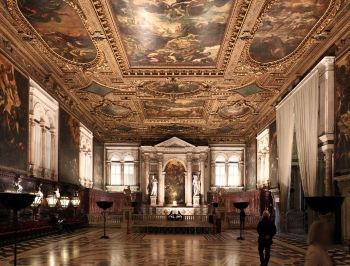
Tintoretto often employed questionably ethical means to secure coveted commissions, at times reducing the fee for his paintings enough to undercut other artists. The most notorious example of his strategic ingenuity centered around a competition for a ceiling painting for the new meeting house of the Scuola Grande di San Rocco in 1564. The prospectus from the confraternity called for selected artists, including Tintoretto, to submit a sketch for the proposed ceiling painting. Tintoretto, rather than providing a sketch, unveiled his completed panel, already installed on the ceiling. When others objected, he presented the painting as a donation, knowing that the confraternity would be obligated to accept a gift. The strategy worked, and by promising to render all additional paintings for the house for an annual salary of 100 ducats, the artist secured an exclusive contract with numerous commissions over the following two decades. Tintoretto was also admitted into the confraternity in 1565, where he would go on to hold various offices.
Late Period
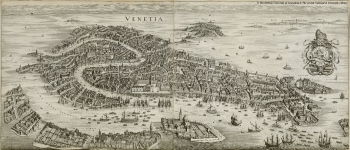
Tintoretto was only known to have left Venice once to travel to Mantua, at the age of 62, in 1580. This was four years after the death of his rival, Titian, who had of all the Venetian painters, dominated the international stage. It was during this later period that Tintoretto also received a few important international commissions including an altarpiece for King Philip II of Spain and four works for the Holy Roman Emperor Rudolf II. He also painted an increasing number of non-religious themed paintings during this time. In these later years, he also created portraits and received many commissions from the Venetian state. One of the most notable being his creation of the large-scale painting, titled Paradiso, in 1592 for the Ducal Palace.
As he neared the end of his life, Tintoretto increasingly relied on the help of his studio assistants to finish his paintings, including Paradiso. Most notable of those assistants were three of his nine children: daughter Marietta and sons Domenico and Marco. The artist was devastated when his oldest daughter, whom he lovingly nicknamed 'la Tintoretta,' died during childbirth in 1590. Just four years later, Tintoretto died fifteen days after contracting a fever. His sons would continue the work of his studio for many years, perhaps still under the guidance of those words Tintoretto had inscribed on its wall years before: Il disegno di Michelangelo e il colorito di Tiziano (The drawing of Michelangelo and the coloring of Titian).
The Legacy of Jacopo Tintoretto
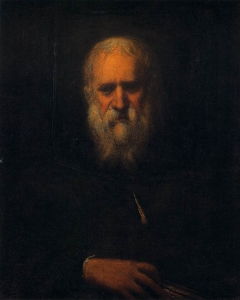
Jacopo Tintoretto left an indelible mark on 16th-century Venetian painting and beyond. His unique approach to artmaking with rapid, loose brushstrokes and strong contrasts between light and dark deeply challenged the traditional style of the iconic master Titian, Paolo Veronese, and his Venetian contemporaries. His bold compositions offered an alternative style to the hierarchal staging of the traditional Renaissance paintings. Because of this, Tintoretto is often associated with the Mannerist painters of the later Renaissance period.
His influence, however, was felt long after his own time. Tintoretto's highly dramatic, almost theatrical compositions would serve as inspiration for the development of the 17th-century Baroque art movement. The impact of his gestural style, notable for its obvious traces of his brushwork, reverberates in the passionate style of Diego Velázquez and Peter Paul Rubens. His early self-portrait, dated to 1548, is considered a precedent to those of later artists including Rembrandt; while the contemplative mood of his much later self-portrait, was described by the modernist icon Edouard Manet as "one of the most beautiful paintings in the world."
Tintoretto's influence continues to permeate the world of painting, impacting contemporary artists most notably in the grand, expressionistic aspects of his compositions. According to Echols and Ilchman, "in our time, such painters as Emilio Vedova, Anselm Kiefer, and Jorge Pombo have specifically measured themselves against Tintoretto, creating huge canvases filled with audacious brushwork and coloristic effects."
Influences and Connections

-
![Albrecht Dürer]() Albrecht Dürer
Albrecht Dürer -
![Michelangelo]() Michelangelo
Michelangelo -
![Raphael]() Raphael
Raphael -
![Titian]() Titian
Titian - Jacopo Sansovino
- Pietro Aretino
- Zuan Francesco Barbo
- Marco Mantova Benavides
- Andrea Calmo
- Tommaso Rangone
-
![Mannerism]() Mannerism
Mannerism -
![Renaissance]() Renaissance
Renaissance - Italian Maniera
-
![Caravaggio]() Caravaggio
Caravaggio -
![El Greco]() El Greco
El Greco -
![Anselm Kiefer]() Anselm Kiefer
Anselm Kiefer -
![Édouard Manet]() Édouard Manet
Édouard Manet - Agostino and Annibale Carracci
-
![Carlo Carrà]() Carlo Carrà
Carlo Carrà ![Henry James]() Henry James
Henry James- Pietro Aretino
- Marco Mantova Benavides
- Andrea Calmo
-
![Baroque Art and Architecture]() Baroque Art and Architecture
Baroque Art and Architecture -
![Mannerism]() Mannerism
Mannerism -
![Romanticism]() Romanticism
Romanticism - Italian Maneria
Useful Resources on Jacopo Tintoretto
- Jacopo Tintoretto 1519-1594 (Masters of Italian Art)
- Tintoretto: Tradition and Identity, Second Expanded EditionOur PickBy Tom Nichols
 Ask The Art Story AI
Ask The Art Story AI